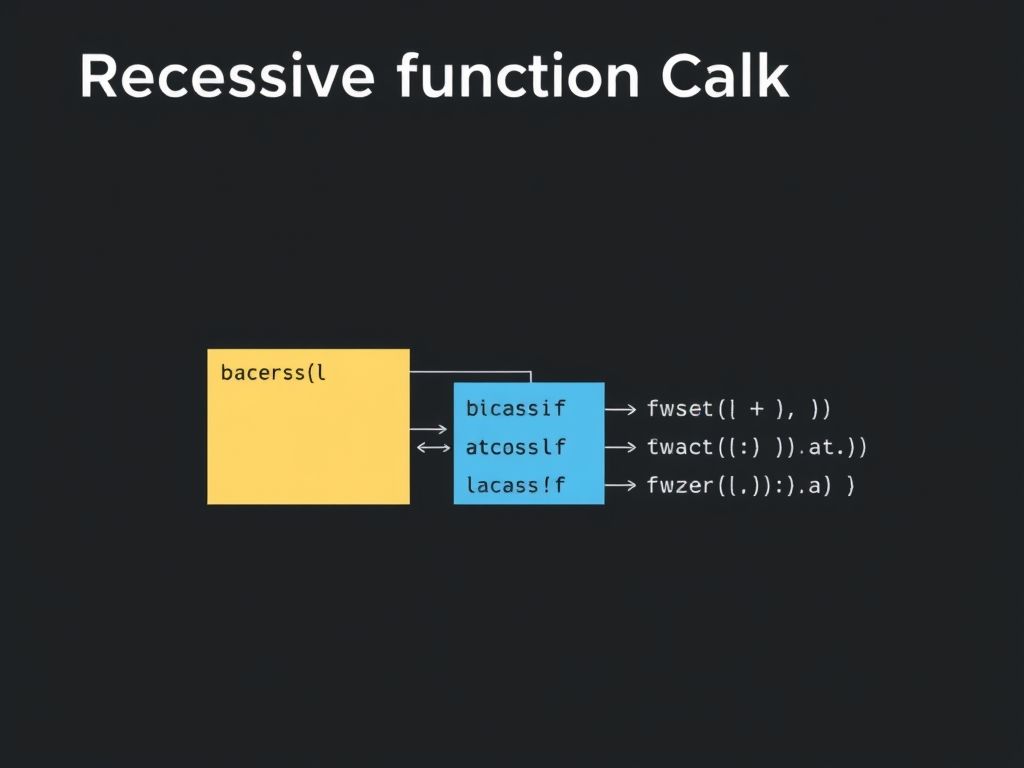Recursive programming, a powerful technique in computer science, allows functions to call themselves. This article delves into the core concepts of recursive algorithms, optimization strategies, and practical applications in programming. Understanding recursion is crucial for tackling complex problems efficiently and elegantly.
Chapter Title: Understanding Recursive Algorithms
Recursion is a powerful technique in computer science and **lập trình**, allowing functions to call themselves. This might seem counterintuitive at first, but it provides an elegant way to solve problems that can be broken down into smaller, self-similar subproblems. Understanding the fundamental principles of recursion is crucial for mastering more complex algorithms and data structures.
At its core, recursion relies on two essential components: the base case and the recursive step. The *base case* is the condition that stops the recursion. Without a base case, the function would call itself indefinitely, leading to a stack overflow error. The *recursive step* is where the function calls itself with a modified input, moving closer to the base case.
Let’s illustrate this with a classic example: calculating the factorial of a number. The factorial of a non-negative integer *n*, denoted as *n*!, is the product of all positive integers less than or equal to *n*. For example, 5! = 5 * 4 * 3 * 2 * 1 = 120.
A recursive function to calculate the factorial can be defined as follows:
- Base Case: If *n* is 0, return 1 (since 0! = 1).
- Recursive Step: Otherwise, return *n* multiplied by the factorial of *n*-1.
Here’s how this might look in code (using Python for simplicity):
“`python
def factorial(n):
if n == 0:
return 1 # Base case
else:
return n * factorial(n-1) # Recursive step
print(factorial(5)) # Output: 120
“`
In this example, the `factorial` function calls itself with a smaller input (`n-1`) until it reaches the base case (`n == 0`). Each recursive call creates a new stack frame, storing the current value of *n* and the return address. Once the base case is reached, the function returns 1, and the stack frames are unwound, multiplying the intermediate results along the way.
Another common example is generating the Fibonacci sequence. The Fibonacci sequence is a series of numbers where each number is the sum of the two preceding ones, usually starting with 0 and 1. The sequence begins: 0, 1, 1, 2, 3, 5, 8, 13, and so on.
A recursive function to calculate the *n*th Fibonacci number can be defined as follows:
- Base Cases: If *n* is 0, return 0. If *n* is 1, return 1.
- Recursive Step: Otherwise, return the sum of the (*n*-1)th and (*n*-2)th Fibonacci numbers.
Here’s the code:
“`python
def fibonacci(n):
if n == 0:
return 0 # Base case 1
elif n == 1:
return 1 # Base case 2
else:
return fibonacci(n-1) + fibonacci(n-2) # Recursive step
print(fibonacci(7)) # Output: 13
“`
While elegant, the recursive Fibonacci implementation is notoriously inefficient due to redundant calculations. For example, `fibonacci(5)` calls `fibonacci(4)` and `fibonacci(3)`. `fibonacci(4)` then calls `fibonacci(3)` and `fibonacci(2)`. Notice that `fibonacci(3)` is calculated twice. This redundancy grows exponentially as *n* increases. This highlights the importance of **tối ưu đệ quy** (optimizing recursion) in practical applications.
Understanding how to break down problems into self-similar subproblems is a key skill in **thuật toán đệ quy** (recursive algorithms). However, it’s equally important to be aware of the potential performance pitfalls of naive recursive implementations.
In the next chapter, we will delve into techniques for optimizing recursive algorithms, such as memoization and dynamic programming, to address these performance concerns. We will explore how these methods can significantly improve efficiency by avoiding redundant calculations and storing intermediate results for reuse. Optimizing Recursive Implementations.
Following our exploration of the foundational principles of recursion in the previous chapter, “Understanding Recursive Algorithms,” where we dissected base cases, recursive steps, and demonstrated recursion through factorial and Fibonacci sequence examples, we now turn our attention to the crucial aspect of optimizing recursive implementations. While recursion offers elegant solutions to certain problems, its naive implementation can often lead to significant performance bottlenecks. This chapter, “Optimizing Recursive Implementations,” delves into techniques that can dramatically improve the efficiency of recursive algorithms.
One of the most potent techniques for optimizing recursive algorithms is **memoization**. Memoization is essentially a form of caching; it involves storing the results of expensive function calls and reusing those results when the same inputs occur again. This is particularly effective for recursive functions where the same subproblems are frequently encountered. Consider the Fibonacci sequence, which we discussed earlier. A straightforward recursive implementation recalculates Fibonacci numbers multiple times, leading to exponential time complexity.
To illustrate memoization, let’s revisit the Fibonacci sequence. A basic recursive function in *Lập trình* would look like this (in pseudocode):
“`
function fibonacci(n):
if n <= 1:
return n
else:
return fibonacci(n-1) + fibonacci(n-2)
```
This is highly inefficient. Now, let's add memoization:
```
function fibonacci_memo(n, memo = {}):
if n in memo:
return memo[n]
if n <= 1:
return n
else:
result = fibonacci_memo(n-1, memo) + fibonacci_memo(n-2, memo)
memo[n] = result
return result
```
In this memoized version, we store the calculated Fibonacci numbers in a dictionary `memo`. Before calculating `fibonacci(n)`, we check if it's already in `memo`. If it is, we simply return the stored value. This drastically reduces the number of recursive calls, transforming the time complexity from exponential to linear. This is a core concept in *Tối ưu đệ quy*.
Another powerful optimization technique closely related to memoization is **dynamic programming**. While memoization takes a top-down approach (solving the problem by breaking it down into smaller subproblems and storing their solutions), dynamic programming typically takes a bottom-up approach. It solves all possible subproblems first and then uses these solutions to build up to the final solution.
For the Fibonacci sequence, a dynamic programming approach would involve building an array of Fibonacci numbers from the bottom up:
“`
function fibonacci_dynamic(n):
fib = [0] * (n + 1)
fib[0] = 0
fib[1] = 1
for i in range(2, n + 1):
fib[i] = fib[i-1] + fib[i-2]
return fib[n]
“`
This dynamic programming solution achieves the same linear time complexity as the memoized version, but it avoids the overhead of recursive function calls altogether. It’s a prime example of *Tối ưu đệ quy*.
Choosing between memoization and dynamic programming often depends on the specific problem and personal preference. Memoization can be more intuitive for some, as it directly mirrors the recursive definition of the problem. Dynamic programming, on the other hand, can sometimes be more efficient, especially when the order in which subproblems need to be solved is well-defined.
Understanding *Thuật toán đệ quy* is crucial for implementing both memoization and dynamic programming effectively. Recognizing overlapping subproblems is the key to identifying opportunities for optimization. By storing and reusing intermediate results, we can transform inefficient recursive algorithms into high-performance solutions.
In summary, optimizing recursive implementations is essential for harnessing the power of recursion without sacrificing performance. Memoization and dynamic programming are two powerful techniques that can significantly improve the efficiency of recursive algorithms by avoiding redundant calculations. These techniques are fundamental to writing efficient code in *Lập trình*, especially when dealing with problems that naturally lend themselves to recursive solutions.
Having explored the optimization of recursive algorithms, the next chapter, “Practical Applications of Recursive Programming,” will delve into real-world scenarios where recursion shines, including tree traversal, searching algorithms, and combinatorial problems. We will examine the advantages and disadvantages of using recursion in various contexts, building upon the optimization techniques discussed here.
Practical Applications of Recursive Programming
Recursive programming, a powerful paradigm in computer science, finds its utility across a multitude of real-world applications. Building upon our previous discussion on “Optimizing Recursive Implementations,” where we explored techniques like memoization and dynamic programming to enhance performance, let’s now delve into specific domains where recursion shines. Remember that optimizing recursive functions, especially using methods like memoization, is crucial for practical applications to avoid stack overflow errors and performance bottlenecks.
One of the most common applications lies in **tree traversal**. Consider a hierarchical data structure like a file system or an organizational chart. Recursive algorithms provide an elegant and efficient way to navigate and process each node in the tree. For example, a depth-first search (DFS) algorithm, often implemented recursively, can systematically explore each branch of a tree before backtracking. This is invaluable for tasks such as searching for a specific file within a directory structure or identifying all employees reporting to a particular manager. The simplicity and clarity of the recursive approach often outweigh the potential overhead, especially when dealing with moderately sized trees.
Another significant area is in **searching algorithms**. As mentioned, depth-first search (DFS) is a prime example. Imagine searching for a path through a maze. A recursive DFS algorithm can explore each possible path until it finds the exit or exhausts all possibilities. Similarly, in graph theory, recursive algorithms are used for tasks like finding connected components and detecting cycles. These algorithms, while conceptually straightforward, can become computationally expensive for large graphs, necessitating optimization techniques, as discussed earlier.
Combinatorial problems are another fertile ground for recursive solutions. Problems like generating permutations, combinations, and subsets often lend themselves to elegant recursive formulations. For instance, consider the problem of generating all possible subsets of a given set. A recursive algorithm can systematically explore each element, either including it in the current subset or excluding it, and then recursively processing the remaining elements. This approach, while conceptually simple, can quickly become computationally intensive as the size of the set increases, highlighting the importance of understanding the time complexity of recursive algorithms. This is where understanding *Thuật toán đệ quy* (recursive algorithms) becomes essential.
The advantages of using recursion include:
- Readability and Elegance: Recursive solutions often mirror the problem’s inherent structure, leading to more concise and understandable code.
- Natural Fit for Certain Problems: As seen with tree traversal and combinatorial problems, recursion provides a natural and intuitive way to express the solution.
- Code Reusability: Recursive functions can often be reused in different parts of the program, promoting modularity.
However, recursion also has its disadvantages:
- Potential for Stack Overflow: Deep recursion can lead to stack overflow errors, especially in languages with limited stack space.
- Performance Overhead: Recursive calls can be more expensive than iterative loops due to the overhead of function calls.
- Debugging Challenges: Tracing the execution of recursive functions can be more difficult than debugging iterative code.
Therefore, choosing between recursion and iteration depends on the specific problem and the constraints of the environment. In many cases, a hybrid approach, combining recursion with optimization techniques like memoization or dynamic programming, can provide the best of both worlds. Understanding *Tối ưu đệ quy* (recursive optimization) is key to making informed decisions.
The choice of using recursion also depends on the programming language (*Lập trình*). Some languages are optimized for tail-call recursion, which avoids stack overflow issues. However, in languages without tail-call optimization, it’s crucial to be mindful of the depth of recursion.
In conclusion, recursive programming offers a powerful and elegant approach to solving a wide range of problems. While it’s essential to be aware of its potential limitations, understanding the advantages and disadvantages of recursion, along with techniques for optimizing recursive implementations, allows programmers to leverage its full potential. The next chapter will explore [transition to the next topic].
Conclusions
Recursive programming offers a unique approach to problem-solving, enabling elegant and often efficient solutions. By understanding its principles, optimization strategies, and practical applications, developers can leverage this powerful technique to tackle complex computational tasks effectively.











